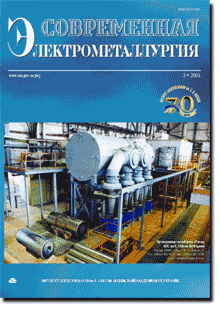| 2004 №02 | 2004 №04 |

CONTENTS

70 years at advanced positions of technical progress 2
ELECTROSLAG TECHNOLOGY
Paton B.E., Medovar L.B. and Saenko V.Ya. About some "old-new" problems of ESR 6
Old and new problems in production of large ingots for large forgings used in heavy and power engineering sectors are considered. New capabilities of the advanced ESR and ESW and their modifications are shown, ensuring improvement of metallurgical quality of large-tonnage ingots and forged-welded billets of alloyed steels and alloys applied in production of superlarge rotors of gas and steam turbines of power plants.
Troyansky A.A., Ryabtsev A.D. and Galyan N.N. Application of electroslag technology for producing iron aluminides 9
The feasibility of producing ingots of iron aluminides Fe3Al and FeAl using a chamber electroslag remelting of steel-aluminium composite consumable electrodes under calcium-containing fluxes in controllable atmosphere is shown. Quality and homogeneity of the produced material were confirmed by chemical and metallographic analyses.
Eryomin E.N. and Zherebtsov S.N. Centrifugal electroslag casting of flange billets using inoculating modifying 13
Method of producing high-quality billets of flange type using the centrifugal electroslag casting with metal modifying by dispersed particles of titanium carbonitride is described. Results of comparative analysis of cast metal are given and advantages of the method are shown.
ELECTRON BEAM PROCESSES
Paton B.E., Trigub N.P., Zhuk G.V., Akhonin S.V. and Berezos V.A. Producing hollow titanium ingots using EBCHM 16
Technology of production of thick-walled hollow large-diameter ingots using the method of electron beam cold hearth melting (EBCHM) was developed. Using a mathematical model the optimum melting conditions were selected. Quality of produced ingots was examined.
Zhuk G.V., Kalinyuk A.N. and Trigub N.P. Production of titanium ingots-slabs using method of EBCHM 20
Technology of production of ingots-slabs of titanium alloy VT6 using the method of electron beam cold hearth melting (EBCHM) was developed. Dependence of structure and properties of ingots metal on melting conditions was investigated. The ways are shown for preventing the anisotropy of properties of titanium alloy rolled metal.
Gavrilyuk O.Ya., Nesynov V.I., Komarov N.S., Rudenko Yu.V., Lebedev B.B. and Podoltsev A.D. Controller of anode current of electron beam guns with a preheated cathode 23
Peculiarities of application of high-frequency transistor converters as an anode current source of electron beam guns with a preheated cathode are considered. The advantage of these converters as compared with traditional mains electric supply sources is shown on the basis of analysis of electromagnetic processes.
PLASMA-ARC TECHNOLOGY
Zhadkevich M.L., Shapovalov V.A., Melnik G.A., Prikhodko M.S., Zhdanovsky A.A. and Zhirov D.M. Engineering method of calculation of main power parameters of plasma ladles-furnaces 31
Method of calculation of main power parameters of plasma ladles-furnaces has been developed. This procedure makes it possible to determine the power and main electric characteristics of plasma heat sources for ladles-furnaces of capacity from 30 to 100 t within the wide range of technological parameters depending on the metal melt heating rate required by the technology.
VACUUM-INDUCTION MELTING
Zhadkevich M.L., Shejko I.V., Teslevich S.M.,Shapovalov V.A., Konstantinov V.S. and Stepanenko V.V. Investigation of composition of gas atmosphere in induction melting of spongy titanium in a sectional mould 34
Composition of gas phase in the zone of spongy titanium melting in use of high-frequency electromagnetic field as a heat source was determined. It was established that hydrogen and moisture are evolved in charge melting. Content of hydrogen and moisture depends on the method of preparation of melting equipment, method of charge feeding, speed of titanium melting and content of chlorine in spongy titanium.
GENERAL PROBLEMS OF METALLURGY
Bulyk I.I., Panasyuk V.V., Trostyanchin A.M., Grigorenko G.M., Kostin V.A., Taranova T.G. and Grigorenko S.G. X-ray and metallographic examinations of phase transformations during Solid-HDDR in ferromagnetic alloy of didymium-iron-boron system 38
Using methods of differential thermal, X-ray phase, electron-microscopic and element analysis, the peculiarities of hydrogen-initiated phase transformations such as hydrogenation, disproportionation, desorption and recombination were studied in ferromagnetic alloy under 0.1-0.5 MPa pressure in the range of temperatures from room to 920 °C. It was shown that alloy is disproportioned in hydrogen at 770 °C, while in vacuum at heating up to 900 °C the products of disproportionation are recombined into initial phase with a highly-dispersed homogeneous structure.
ELECTROMETALLURGY OF STEEL AND FERROALLOYS
Chepurnoj A.D., Razinkin B.I., Tsertsek A.B., Kovalyov A.G. and Leontiev A.A. Investigation of steel degassing in electric arc melting and circulation vacuum degassing 42
Effect of main technological parameters of electric arc melting and vacuum degassing on the degree of changing the content of hydrogen and nitrogen in molten steel was studied. After mathematical processing of experimental data of electric arc melts, the equations of dependence of hydrogen content in steel on the rate of carbon oxidation, duration of reduction period and also of its dependence in vacuum degassing on the metal cooling rate, duration of vacuum degassing and steel temperature were derived.
Kostyakov V.N., Najdek V.L., Poletaev E.B.,Grigorenko G.M., Bystrov Yu.A. and Medved S.N. Specifics of metals reduction by carbon from oxide materials in liquid-phase reduction melting 45
Behavior of carbon in the process of liquid-phase reduction melting of iron-ore concentrate in DC arc furnace was investigated. It is shown that the high degree of iron reduction and decreased carbon losses are provided in adding of a reducing agent to the briquettes together with oxide-containing materials.
ENERGY AND RESOURCE SAVING
Lakomsky V.I. and Grigorenko G.M. Specifics of thermoanthracite heating in AC electric field 48
Model of furnace-calcinator of anthracite was created allowing visualization of the process of electric contact heating of coal. Specifics of thermoanthracite grains heating was studied preliminary.
INFORMATION
Jubilee of International Center of Electron Beam Technologies of the E.O. Paton Electric Welding Institute of the NAS of Ukraine 51
(You are viewing the simplified file contents)
